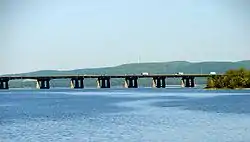Rivière à l'Orme
The Rivière à l'Orme (English: Elm River) is a tributary of the Lac des Deux Montagnes, flowing into the territory of Pierrefonds, Quebec and Senneville, Quebec, in the city of Montreal, in Quebec, in Canada.
| Rivière à l’Orme English: Elm River | |
|---|---|
 Île aux Tourtes Bridge across Lake of Two Mountains, with Mont Oka in the background | |
| Location | |
| Country | Canada |
| Province | Quebec |
| Region | Montreal |
| Physical characteristics | |
| Source | Urban creek |
| • location | Pierrefonds, Quebec, Montreal, Quebec |
| • coordinates | 45°26′35″N 73°53′07″W |
| • elevation | 31 m (102 ft) |
| Mouth | Lac des Deux Montagnes (anse à l’Orme) |
• location | Senneville, Quebec, Montreal, Quebec |
• coordinates | 45°27′01″N 73°56′17″W |
• elevation | 23 m (75 ft) |
| Length | 5.1 km (3.2 mi)[1] |
The course of the river mainly passes through urban areas with urban park areas.
Annually, the surface of the river is generally frozen from mid-December to late March, however, the period of safe ice circulation is usually from late December to mid-March.
Geography
The hydrographic slopes adjacent to the "rivière à l’Orme" are:
- North side: Lac des Deux Montagnes, Ottawa River;
- East side: Rivière des Prairies, Lake St. Louis;
- South side: Lake St. Louis, St. Lawrence River;
- West side: Lac des Deux Montagnes.
The "rivière à l’Orme" originates in the southwestern part of the Pierrefonds borough of Montréal, on the west side of the Cineplex Kirkland Theater.
From its source, the "rivière à l’Orme" flows over 5.1 kilometres (3.2 mi) according to the following segments:
- 1.5 kilometres (0.93 mi) southwesterly along the north side of autoroute 40 and cutting off the Timberlea Trail up to an urban stream (coming from South of autoroute 40);
- 3.6 kilometres (2.2 mi) northwesterly up to its mouth. Note: the “Anse à l'Orme road” runs along this segment, first on the North-East side and then on the South-West side.[2]
The "rivière à l’Orme" empties on the East shore of “Anse à l'Orme”, which is a natural extension of the Lac des Deux Montagnes. At the end of the course, this river crosses the L'Anse-à-l'Orme Nature Park. This cove is bounded by Pointe Madeleine (North side) and Pointe Boyer (South West side). The mouth of this river is located at:
- 2.6 kilometres (1.6 mi) South of the mouth of the Lac des Deux Montagnes;
- 5.5 kilometres (3.4 mi) North of the Galipeault Bridge on Highway 20, connecting the borough of Sainte-Anne-de-Bellevue, Quebec and the Perrot Island;
- 2.8 kilometres (1.7 mi) south of Île Bizard, a borough of Montréal;
- 5.4 kilometres (3.4 mi) in the South-East, opposite of Pointe-Calumet.[2]
Toponymy
Since at least 1925, some documents attest to the use of the toponym "Rivière à l’Orme", designating this urban stream. This designation (in its present form) evokes the work of life of “Julien Hubert dit de Lorme”. The latter benefited from a concession in 1668, a lot of land adjacent to the Orme cove, located at the western end of the island of Montreal, just South-West of the “Cap à l'Orme”. In the past, many historians mistakenly believed that this toponymic designation was explained by the presence of elms in this area. The toponymic names "Cap à l'Orme », « Anse à l'Orme » and « Rivière à l'Orme" are intertwined.
The toponym "Rivière à l'Orme" was formalized on December 5, 1968, at the Commission de toponymie du Québec, i.e. at the creation of the Commission.[3]
Notes and references
- Atlas of Canada
- Distances measured from the Atlas of the Canada (published on the Internet) of the Department of Natural Resources Canada.
- Commission de toponymie du Quebec - Bank of Place Names - Toponym: "Rivière à l'Orme"
See also
- Ottawa River, a watercourse
- Lac des Deux Montagnes, a body of water
- Rivière-des-Prairies, a watercourse
- L'Anse-à-l'Orme Nature Park, an urban park
- Pierrefonds, Quebec, an agglomeration of Montreal
- Senneville, Quebec, a city on the West Island of Montreal.
- List of rivers of Quebec